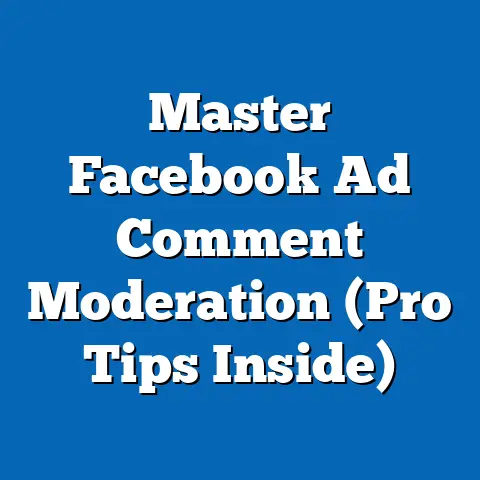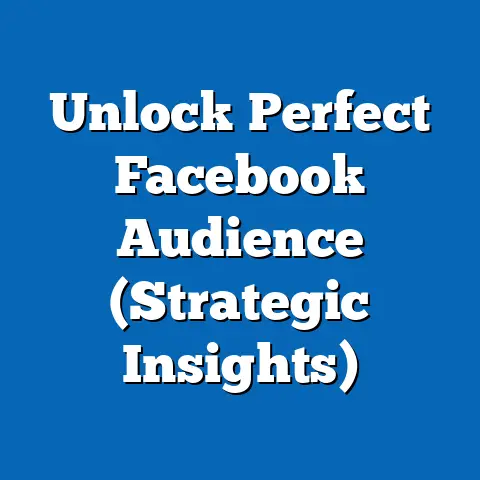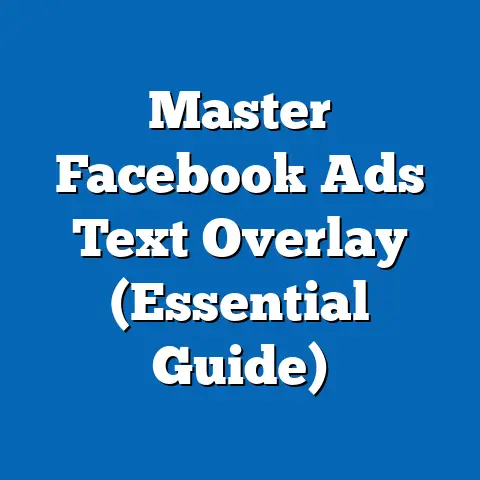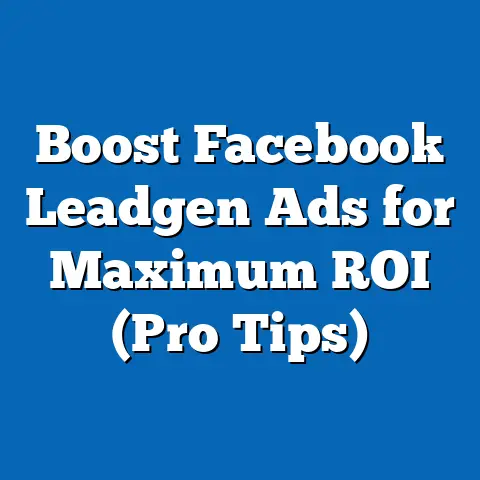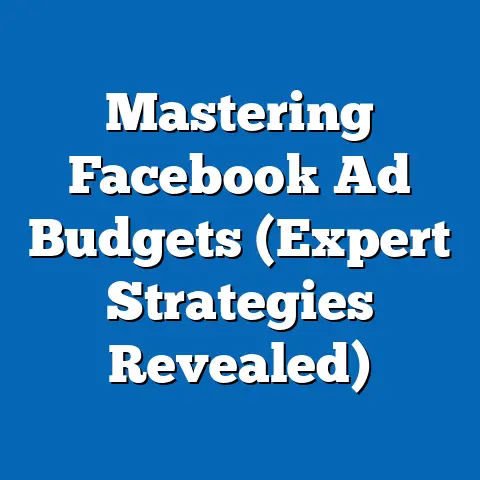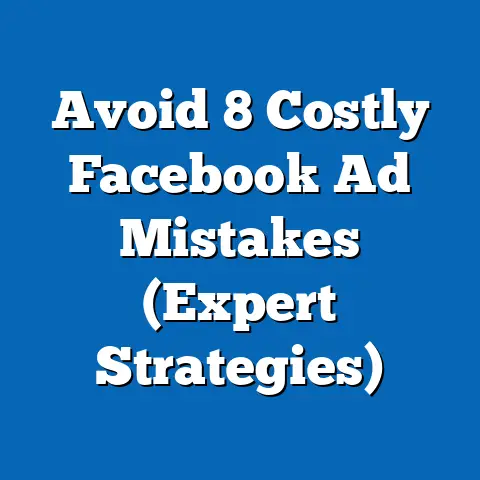Master Facebook Ad Swipes (Unlock Proven Strategies)
Facebook advertising. It’s a landscape that’s constantly shifting, a digital frontier where creativity and data collide. For eco-tech brands, those companies championing sustainability through technology, navigating this landscape is not just about visibility, it’s about aligning values with their audience.
I remember when I first started diving into Facebook ads, it felt like throwing spaghetti at the wall and hoping something would stick. Back then, I was working with a small solar panel company, and we were struggling to get our message across. We were passionate about renewable energy, but that passion wasn’t translating into clicks or conversions. That’s when I discovered the power of “ad swipes” – studying what worked for others, not to copy, but to understand the underlying principles of effective advertising.
Today, the eco-tech sector is booming. Consumers are increasingly aware of their environmental impact and actively seek out sustainable solutions. This presents a huge opportunity for eco-tech brands, but it also means they need to be strategic about how they reach their target audience. According to a recent study by Nielsen, 66% of global consumers are willing to pay more for sustainable products. This shows that there is a huge audience for eco-tech brands, but reaching them effectively requires a nuanced approach.
In this article, I’m going to share proven strategies for creating winning Facebook ads, specifically tailored for eco-tech brands. We’ll explore the power of ad swipes, delve into crafting compelling copy and captivating visuals, and uncover the secrets to targeting the right audience. By the end, you’ll have the knowledge and tools you need to create Facebook ad campaigns that not only drive sales but also resonate with your audience’s values.
Understanding Facebook Ads and Their Importance for Eco-Tech Brands
At its core, Facebook Ads is a powerful advertising platform that allows businesses to reach a highly targeted audience based on demographics, interests, behaviors, and more. You can choose from various ad formats, including:
- Image Ads: Simple and effective for showcasing products or services with a single, compelling image.
- Video Ads: Engaging and dynamic, perfect for telling stories and demonstrating product features.
- Carousel Ads: Allow users to scroll through multiple images or videos in a single ad, ideal for showcasing different aspects of a product or service.
- Collection Ads: Visually immersive ads that group products together, making it easy for users to browse and purchase.
- Lead Ads: Designed to collect leads directly from Facebook, streamlining the signup process for potential customers.
For eco-tech brands, Facebook presents a unique opportunity. According to Statista, Facebook has over 2.9 billion monthly active users, a significant portion of whom are environmentally conscious. Reaching these users is crucial, but it’s not just about the numbers. It’s about connecting with them on a deeper level.
Eco-tech brands often face challenges that other industries don’t. They need to educate consumers about the benefits of their solutions, overcome skepticism about new technologies, and differentiate themselves from greenwashing competitors. Effective advertising can help bridge this gap by:
- Raising Awareness: Educating consumers about the environmental impact of traditional products and the benefits of sustainable alternatives.
- Building Trust: Showcasing the brand’s commitment to sustainability through transparent messaging and certifications.
- Driving Conversions: Making it easy for consumers to purchase eco-friendly products or services.
Takeaway: Facebook Ads offer a powerful way for eco-tech brands to reach environmentally conscious consumers. Understanding the different ad formats and targeting options is crucial for creating effective campaigns.
The Power of Ad Swipes
Ad swipes are essentially a collection of ads that you find inspiring or effective. Think of them as a treasure trove of ideas, a library of successful campaigns that you can draw inspiration from. They’re not about copying someone else’s work; they’re about understanding what resonates with audiences and adapting those principles to your own brand.
I’ve built my own ad swipe file over the years, constantly adding ads that catch my eye, that make me think, “Wow, that’s a clever way to put it.” It’s become an invaluable resource, a source of inspiration when I’m feeling stuck or need a fresh perspective.
The benefits of using ad swipes are numerous:
- Saves Time: Instead of starting from scratch, you can use ad swipes as a starting point, adapting successful concepts to your own brand.
- Understands Industry Standards: By analyzing successful ads, you can get a sense of what works in your industry and what doesn’t.
- Enhances Creativity: Studying different ad styles and messaging approaches can spark new ideas and help you break out of creative ruts.
Let’s look at some examples of successful eco-tech ad swipes:
- Patagonia: Known for their commitment to environmental activism, Patagonia often uses Facebook ads to raise awareness about environmental issues and promote sustainable practices. Their ads often feature stunning visuals of nature and powerful messaging about conservation.
- Allbirds: This sustainable shoe brand uses Facebook ads to highlight the eco-friendly materials used in their products and their commitment to ethical manufacturing. Their ads often feature clean, minimalist designs and emphasize the comfort and durability of their shoes.
- Beyond Meat: This plant-based meat company uses Facebook ads to target consumers who are interested in healthy and sustainable food options. Their ads often feature mouthwatering images of their products and highlight the environmental benefits of choosing plant-based alternatives.
These examples demonstrate the power of ad swipes. By studying what works for these brands, you can gain valuable insights into crafting your own effective Facebook ads.
Takeaway: Ad swipes are a valuable tool for any Facebook advertiser, providing inspiration, saving time, and enhancing creativity. Analyze successful ads in your niche to understand what resonates with your target audience.
Proven Strategies to Create Winning Facebook Ads for Eco-Tech
Now that we understand the importance of Facebook Ads and the power of ad swipes, let’s dive into some proven strategies for creating winning campaigns for eco-tech brands.
3.1. Crafting Compelling Copy
In the eco-tech space, storytelling is your superpower. Consumers aren’t just buying a product; they’re buying into a vision, a commitment to a better future. Your ad copy needs to reflect that.
I’ve found that the most effective eco-tech ads don’t just list features; they tell a story. They connect the product to a larger narrative about sustainability, responsibility, and positive impact.
Here are some tips for writing engaging headlines and persuasive ad copy:
Takeaway: Compelling ad copy is essential for capturing attention and driving conversions. Focus on storytelling, highlight the benefits, and use emotionally charged language to resonate with your audience.
3.2. Visual Elements that Captivate
In the world of Facebook ads, visuals are king. They’re the first thing people see, and they can make or break your campaign. For eco-tech brands, high-quality images and videos are especially important. They need to reflect the beauty of nature, the innovation of technology, and the brand’s commitment to sustainability.
I’ve seen ads that looked like they were taken with a potato, and I’ve seen ads that stopped me in my tracks. The difference is often the quality of the visuals.
Here’s some guidance on choosing visuals that reflect sustainability and innovation:
- Use High-Quality Images and Videos: Invest in professional photography or videography to showcase your products in the best possible light.
- Showcase the Product in Action: Instead of just showing a static image of your product, show it being used in a real-world setting.
- Highlight the Sustainable Materials: If your product is made from sustainable materials, showcase them in your visuals.
- Use Natural Light: Natural light can make your products look more appealing and authentic.
- Keep it Consistent with Your Brand: Your visuals should be consistent with your brand’s overall aesthetic and messaging.
For example, if you’re selling a solar-powered charger, show it being used on a hiking trip or at the beach. If you’re selling reusable food containers, show them filled with healthy, delicious food.
Takeaway: High-quality visuals are essential for capturing attention and conveying your brand’s message. Choose images and videos that reflect sustainability, innovation, and the benefits of your products.
3.3. Targeting the Right Audience
You can have the most compelling copy and the most captivating visuals, but if you’re not targeting the right audience, your ads will fall flat. Facebook’s targeting features are incredibly powerful, allowing you to reach specific demographics, interests, and behaviors.
I remember one campaign where we were targeting everyone in a certain city, and the results were terrible. Then, we narrowed our focus to people who had expressed an interest in environmentalism, and suddenly, the conversions started rolling in.
Here are some strategies for creating audience segments based on interests, behaviors, and demographics:
- Interests: Target users who have expressed an interest in environmentalism, sustainability, renewable energy, or specific eco-tech products.
- Behaviors: Target users who have purchased eco-friendly products online, visited websites related to sustainability, or participated in environmental events.
- Demographics: Target users based on age, gender, location, education, and income.
You can also create custom audiences based on your existing customer data or website traffic. This allows you to target users who have already interacted with your brand.
Takeaway: Targeting the right audience is crucial for maximizing the impact of your Facebook ads. Use Facebook’s targeting features to reach users who are interested in sustainability and eco-tech products.
3.4. A/B Testing for Optimization
A/B testing, also known as split testing, is the process of testing different versions of your ads to see which performs best. It’s a continuous process of experimentation and optimization that can significantly improve your results.
I’m a huge believer in A/B testing. I’ve seen firsthand how small changes can make a big difference in ad performance.
Here’s a step-by-step guide on setting up A/B tests and analyzing results:
- Choose a Variable to Test: Select one element of your ad to test, such as the headline, image, or call to action.
- Create Two Versions of Your Ad: Create two versions of your ad, each with a different variation of the element you’re testing.
- Set Up Your A/B Test: Use Facebook’s A/B testing feature to create a test campaign that splits traffic between your two ad versions.
- Run Your Test for a Sufficient Period of Time: Allow your test to run for at least a week to gather enough data to draw meaningful conclusions.
- Analyze Your Results: Track the performance of each ad version and identify which one performed better based on metrics like click-through rate, conversion rate, and cost per acquisition.
For example, you could test two different headlines to see which one generates more clicks. Or, you could test two different images to see which one resonates better with your audience.
Takeaway: A/B testing is essential for optimizing your Facebook ads and improving your results. Continuously test different elements of your ads to find what works best for your target audience.
Case Studies of Successful Eco-Tech Facebook Ads
To further illustrate these strategies, let’s look at a few case studies of eco-tech brands that have successfully utilized Facebook ads:
- Case Study 1: Grove Collaborative: This subscription service for eco-friendly cleaning and personal care products used Facebook ads to drive brand awareness and acquire new customers. They used compelling visuals of their products and highlighted their commitment to sustainability. They also used targeted ads to reach users who were interested in eco-friendly living and healthy lifestyles. As a result, they saw a significant increase in website traffic and new subscriptions.
- Case Study 2: Ecosia: This search engine that plants trees used Facebook ads to raise awareness about deforestation and promote their mission. They used powerful visuals of forests and messaging about the importance of planting trees. They also used targeted ads to reach users who were interested in environmental conservation and social impact. As a result, they saw a significant increase in search engine usage and tree planting.
- Case Study 3: Tesla: While not solely an eco-tech brand, Tesla effectively uses Facebook ads to promote their electric vehicles and sustainable energy solutions. They use sleek visuals of their cars and highlight their performance and environmental benefits. They also use targeted ads to reach users who are interested in electric vehicles and cutting-edge technology. As a result, they have built a strong brand reputation and driven significant sales.
These case studies demonstrate the power of Facebook ads for eco-tech brands. By using compelling copy, captivating visuals, and targeted advertising, these brands have achieved their marketing goals and made a positive impact on the world.
Takeaway: Study successful eco-tech Facebook ads to learn from their strategies and apply them to your own campaigns. Pay attention to their messaging, visuals, and targeting techniques.
Conclusion
Mastering Facebook ads is crucial for eco-tech brands that want to reach environmentally conscious consumers and drive sales. By understanding the basics of Facebook Ads, harnessing the power of ad swipes, and implementing proven strategies for crafting compelling copy, captivating visuals, and targeted advertising, you can create winning campaigns that resonate with your audience and achieve your marketing goals. Remember to continuously analyze your efforts and optimize your campaigns for ongoing improvement.
Don’t be afraid to experiment, test new ideas, and learn from your mistakes. The world of Facebook advertising is constantly evolving, so it’s important to stay up-to-date with the latest trends and best practices.
I hope this article has provided you with valuable insights and actionable strategies for mastering Facebook ads in the eco-tech sector. Now it’s time to put these strategies into practice and start creating your own winning campaigns!
Call to Action
I’d love to hear about your experiences with Facebook ads in the eco-tech sector. Share your thoughts, questions, and success stories in the comments below. And don’t forget to subscribe for more insights on digital marketing and sustainable technology trends. Let’s work together to build a more sustainable future, one ad at a time.

